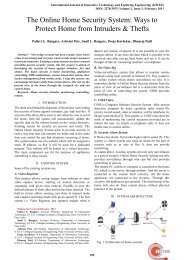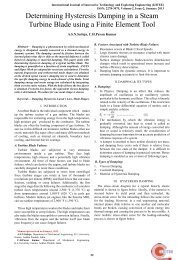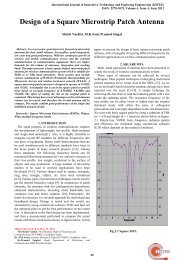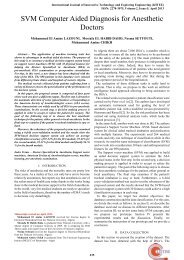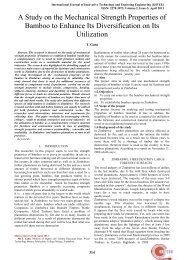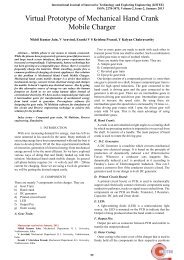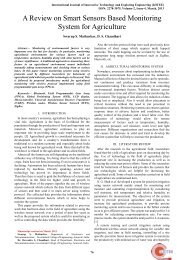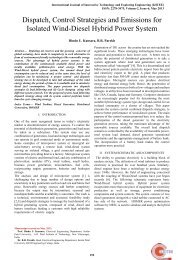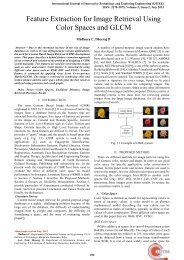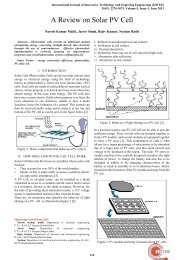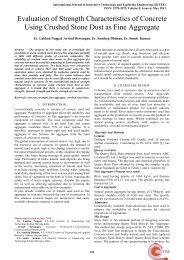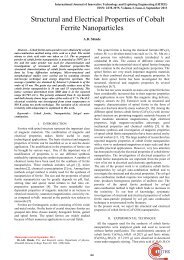Physico-Chemical Analysis of Surface and Ground Water of ...
Physico-Chemical Analysis of Surface and Ground Water of ...
Physico-Chemical Analysis of Surface and Ground Water of ...
Create successful ePaper yourself
Turn your PDF publications into a flip-book with our unique Google optimized e-Paper software.
International Journal <strong>of</strong> Innovative Technology <strong>and</strong> Exploring Engineering (IJITEE)<br />
ISSN: 2278-3075, Volume-2, Issue-5, April 2013<br />
<strong>Physico</strong>- <strong>Chemical</strong> <strong>Analysis</strong> <strong>of</strong> <strong>Surface</strong> <strong>and</strong><br />
<strong>Ground</strong> <strong>Water</strong> <strong>of</strong> Abhanpur Block in Raipur<br />
District, Chhattisgarh, INDIA<br />
Pramisha Sharma, Amit Dubey, S.K. Chatterjee<br />
Abstract—A segment <strong>of</strong> this investigation was carried out to<br />
study the ground water as well as surface water quality <strong>and</strong> its<br />
physico-chemical characteristics <strong>of</strong> Abhanpur block district<br />
Raipur <strong>of</strong> Chhattisgarh, India. The geographical area at study is<br />
situated between 21 0 3’ N to 21 0 35’4” N latitude <strong>and</strong> 81 0 43’ E to<br />
49.64’5” E longitude. The present work has been conducted by<br />
monitoring <strong>of</strong> ground <strong>and</strong> surface water i.e. well water, bore - well<br />
water <strong>of</strong> 8 wards <strong>of</strong> Abhanpur block as well as pond <strong>and</strong> tap water<br />
<strong>of</strong> the Abhanpur. Attempts were made to study <strong>and</strong> analyze the<br />
physico-chemical characteristics <strong>of</strong> water, i.e. , temperature, pH,<br />
total dissolved solids, alkalinity, hardness, <strong>and</strong> chloride.<br />
Key words—<strong>Ground</strong> water, <strong>Surface</strong> water, <strong>Physico</strong>chemical<br />
parameter, Raipur district.<br />
I. INTRODUCTION<br />
Much <strong>of</strong> current concern with regard to environmental<br />
quality is focused on water because <strong>of</strong> its importance in<br />
maintaining human health <strong>and</strong> the ecosystem. Fresh water is<br />
a finite resource, essential for agriculture, industry <strong>and</strong> even<br />
human existence, without fresh water <strong>of</strong> adequate quantity<br />
<strong>and</strong> quality, sustainable development will not be possible 1 .<br />
There is an extensive literature available that underscores<br />
deterioration <strong>of</strong> water quality 2-5 . The addition <strong>of</strong> various<br />
kinds <strong>of</strong> pollutants <strong>and</strong> nutrients through urban sewage,<br />
industrial effluents, agricultural run<strong>of</strong>f etc. into the water<br />
bodies brings about a series <strong>of</strong> changes in the<br />
physicochemical quality <strong>and</strong> its characteristics <strong>of</strong> water. This<br />
has been subject <strong>of</strong> several investigations 6-10 .<br />
Fresh water resource is becoming day by day at the foster<br />
rate <strong>of</strong> deterioration <strong>of</strong> the water quality is now a global<br />
problem 11 . Discharge <strong>of</strong> toxic chemicals, over pumping <strong>of</strong><br />
qualifier <strong>and</strong> contamination <strong>of</strong> water bodies with substance<br />
that promote algae growth are some <strong>of</strong> the today’s major<br />
cause for water quality degradation. Organic manure,<br />
municipal waste <strong>and</strong> some fungicides <strong>of</strong>ten contain fairly high<br />
concentration <strong>of</strong> heavy metals. Soils receiving repeated<br />
applications <strong>of</strong> organic manures, fungicides <strong>and</strong> pesticides<br />
have exhibited high concentration <strong>of</strong> extractable heavy metals<br />
<strong>and</strong> that thereby increase their concentration in run<strong>of</strong>f, while<br />
falling as rain, water picks up small amounts <strong>of</strong> gases, ions,<br />
dust <strong>and</strong> particulate matter from the atmosphere 12-13 . These<br />
added substances may be arbitrarily classified as biological,<br />
chemical, physical <strong>and</strong> radiological impurities 14 .<br />
Manuscript received on April, 2013.<br />
Pramisha Sharma, Asst. Pr<strong>of</strong>. <strong>and</strong> Research Scholar, Chemistry, M.M.<br />
College <strong>of</strong> Technology, Raipur (C.G.) India.<br />
Dr. Amit Dubey, Senior Scientist, Chhattisgarh Council <strong>of</strong> Science <strong>and</strong><br />
Tecnology, Raipur (C.G.) India,<br />
Dr. S.K. Chatterjee, Principal, Govt.Arts, Commerce <strong>and</strong> Science<br />
College , Tilda, Distt. Raipur (C.G.), India.<br />
These impurities may give water a bad taste, color, odour,<br />
turbidity <strong>and</strong> cause hardness, corrosiveness, staining or<br />
frothing 15 . The composition <strong>of</strong> surface <strong>and</strong> ground water<br />
depend on natural factors (geological, topographical,<br />
metrological, hydrological <strong>and</strong> biological) in the drainage<br />
basin <strong>and</strong> varies with seasonal difference in run <strong>of</strong>f volume,<br />
weather conditions <strong>and</strong> water levels. 16<br />
<strong>Ground</strong>water is one is the important resource all over the<br />
world. The term groundwater is usually reserved for the<br />
subsurface water that occurs beneath the water table in soils<br />
<strong>and</strong> geologic formation that are fully saturated 17 . It supports<br />
drinking water supply; livestock needs irrigation industrial<br />
<strong>and</strong> many commercial activities 18 . <strong>Ground</strong>water is generally<br />
less susceptible to contamination <strong>and</strong> pollution when<br />
compared to surface water bodies 19 . Also the natural<br />
impurities in rainwater, which replenishes groundwater<br />
systems, get removed while infiltrating through soil strata.<br />
But, in India, where groundwater is used intensively for<br />
irrigation <strong>and</strong> industrial purposes, a variety <strong>of</strong> l<strong>and</strong> <strong>and</strong> water<br />
based human activities are causing pollution <strong>of</strong> this precious<br />
resource 20 . Importantly, groundwater can also be contained<br />
by naturally occurring sources. Soil <strong>and</strong> geologic formation<br />
containing high levels <strong>of</strong> heavy metals can leach those metals<br />
into groundwater. This can be aggravated by over-pumping<br />
wells, particularly for agriculture. Pollution caused by<br />
fertilizers <strong>and</strong> pesticides used in agriculture, <strong>of</strong>ten dispersed<br />
over large areas, is a great threat to fresh groundwater<br />
ecosystems.<br />
Pollution <strong>of</strong> groundwater due to industrial effluents <strong>and</strong><br />
municipal waste in water bodies is another major concern in<br />
many cities <strong>and</strong> industrial clusters in India. <strong>Ground</strong>water is<br />
very difficult to remediate, except in small defined areas <strong>and</strong><br />
therefore the emphasis has to be on prevention. Owing to the<br />
human activities, the ponds have become dumping ground <strong>of</strong><br />
domestic wastes <strong>and</strong> other refuse <strong>of</strong> the society 21 . So, the<br />
knowledge <strong>of</strong> extent <strong>of</strong> pollution <strong>and</strong> the status <strong>of</strong> water<br />
become essential in order to preserve the valuable sources <strong>of</strong><br />
water for future generation. <strong>Water</strong> quality guidelines provide<br />
basic scientific information about water quality parameter <strong>and</strong><br />
ecologically relevant toxicological threshold values to protect<br />
specific water uses. Important physical <strong>and</strong> chemical<br />
parameters influencing the aquatic environment are<br />
temperature, pH, alkalinity, hardness, chloride, <strong>and</strong> total<br />
dissolved solid.<br />
The main objective <strong>of</strong> this work has to analyze various<br />
physico-chemical parameters <strong>of</strong> the surface <strong>and</strong> ground water<br />
<strong>of</strong> (Abhanpur Block) Raipur District C.G.<br />
II. MATERIALS AND METHOD<br />
Sampling & Preservation: - The water samples were<br />
drawn during post monsoon (Nov-Jan). The ground <strong>and</strong><br />
surface water were collected from different wards <strong>of</strong><br />
71
Abhanpur<br />
(1)<br />
Gatapar<br />
(2)<br />
Manikchauri<br />
(3)<br />
Bajarangpur<br />
(4)<br />
Kurrta<br />
(5)<br />
Gobranawapara<br />
(6)<br />
Tarri<br />
(7)<br />
Paragoan<br />
(8)<br />
Abhanpur<br />
(1)<br />
Gatapar<br />
(2)<br />
Manikchauri<br />
(3)<br />
Bajarangpur<br />
(4)<br />
Abhanpur<br />
(1)<br />
Gatapar<br />
(2)<br />
Manikchauri<br />
(3)<br />
Bajarangpur<br />
(4)<br />
Kurrta<br />
(5)<br />
Gobranawapar<br />
a<br />
(6)<br />
Tarri<br />
(7)<br />
Paragoan<br />
(8)<br />
Kurrta<br />
(5)<br />
Gobranawapara<br />
(6)<br />
Tarri<br />
(7)<br />
Paragoan<br />
(8)<br />
<strong>Physico</strong>-<strong>Chemical</strong> <strong>Analysis</strong> <strong>of</strong> <strong>Surface</strong> <strong>and</strong> <strong>Ground</strong> <strong>Water</strong> <strong>of</strong> Abhanpur Block in Raipur District, Chhattisgarh, INDIA<br />
Abhanpur Block in Raipur district C.G. <strong>Water</strong> samples from<br />
different location were collected in the plastic bottles <strong>of</strong> 250<br />
ml from well, Bore well, pond <strong>and</strong> tap water. Samples<br />
collected were analyzed within 2 days go in order to avoid<br />
special preservation required. However sample in the bottles<br />
were kept in the refrigerator. St<strong>and</strong>ard testing methods are<br />
used to evaluate different parameter 22 .<br />
The pH <strong>of</strong> the ground water was estimated by pH meter.<br />
The alkalinity <strong>of</strong> water is generally due to present <strong>of</strong><br />
carbonate <strong>and</strong> hydroxide ion. Alkalinity provides an idea <strong>of</strong><br />
the nature <strong>of</strong> salts present in the water. The total alkalinity <strong>of</strong><br />
ground water was calculated by st<strong>and</strong>ard titration method.<br />
The total solid (TS) present in 100 ml <strong>of</strong> sample water was at<br />
103 0 to 105 0 c to dryness in drying oven. Cooling is done<br />
desiccators <strong>and</strong> then weight. The TS in mg/l. =<br />
(A–B)×100/sample volume in litre. Where A = weight <strong>of</strong><br />
(dried residue + dish) & B = weight <strong>of</strong> dish. The total<br />
suspended solid (TSS) was calculated by the following<br />
formula: Total suspended solid (mg)/liter = (A–B) ×<br />
100/sample vol. in liter, where, A = weight <strong>of</strong> filter + dried<br />
residue. B = weight <strong>of</strong> filter paper. The total dissolved solids<br />
(TDS) term is used to describe the inorganic salts <strong>and</strong> small<br />
amount <strong>of</strong> organic matter present in solution. It was calculated<br />
by adding calcium <strong>and</strong> magnesium hardness derived by<br />
EDTA titration method. The chloride was estimated by silver<br />
nitrate titration method. Temperature <strong>of</strong> the samples measure<br />
by thermometer.<br />
III. RESULTS & DISCUSSION<br />
The physico-chemical characteristics <strong>of</strong> surface <strong>and</strong> ground<br />
water <strong>of</strong> the study area (Abhanpur Block) <strong>of</strong> Raipur District<br />
Table: 1 The physico-chemical characteristics <strong>of</strong> Tap<br />
water samples in (Abhanpur Block) <strong>of</strong> District Raipur.<br />
HARDNESS<br />
TDS<br />
CHLORIDE<br />
TEMPERAT<br />
-URE<br />
Desirable 300mg/l.<br />
permissible 600mg/l<br />
Desirable 500mg/l.<br />
permissable2000mg/<br />
Desirable 250mg/l.<br />
permissible<br />
10000mg/<br />
240 270 190 200 280 170 190 130<br />
612 828 528 660 528 552 444 576<br />
100 40 80 70 80 80 50 180<br />
21.8 21.6 22 21 21.5 21 22 21<br />
Table: 3 The physico-chemical characteristics <strong>of</strong> well water<br />
samples in (Abhanpur Block) <strong>of</strong> District Raipur.<br />
Parameter<br />
BIS-st<strong>and</strong>ards<br />
(mg|l) WW1 WW2 WW3 WW4 WW5 WW6 WW7 WW8<br />
pH 6.5-9.2 8.5 0.0 8.0 8.0 8.0 6.5 8.5 8.0<br />
ALKALINITY<br />
Desirable 200mg/l.<br />
permissible<br />
140 130 280 190 130 140 330 140<br />
600mg/l<br />
HARDNESS<br />
Desirable 300mg/l.<br />
permissible<br />
180 110 190 300 110 260 100 180<br />
600mg/l<br />
TDS<br />
Desirable 500mg/l.<br />
permissible<br />
396 420 852 840 336 684 612 456<br />
2000mg/<br />
CHLORIDE<br />
Desirable 250mg/l.<br />
permissible<br />
10 0 240 210 40 270 80 60<br />
10000mg/<br />
TEMPERAT<br />
-URE<br />
21.8 21.0 22 21 21.5 21 22 21<br />
Table: 4 The physico-chemical characteristics <strong>of</strong> pond water<br />
samples in (Abhanpur Block) <strong>of</strong> District Raipur.<br />
Parameter<br />
BIS-st<strong>and</strong>ards<br />
(mg/l) PW1 PW2 PW3 PW4 PW5 PW6 PW7 PW8<br />
pH 6.5-9.2 8.0 8.5 8.0 7.5 8.0 8.5 8.5 8.5<br />
ALKALINITY<br />
Desirable 200mg/l.<br />
permissible 600mg/l<br />
100 160 230 60 100 150 160 110<br />
HARDNESS<br />
TDS<br />
CHLORIDE<br />
TEMPERAT<br />
-URE<br />
Desirable 300mg/l.<br />
permissible 600mg/l<br />
Desirable 500mg/l.<br />
permissible 2000mg/<br />
Desirable 250mg/l.<br />
permissible 10000mg/<br />
110 150 100 150 100 110 140 100<br />
312 456 552 168 276 360 408 312<br />
50 70 130 30 30 40 40 50<br />
21.8 21.6 22.0 21.0 21.5<br />
0<br />
21.0<br />
22.0 22.1<br />
Table No. 2 The physico-chemical characteristics <strong>of</strong><br />
Bore-well water samples in (Abhanpur Block) <strong>of</strong> District<br />
Raipur.<br />
Parameter<br />
BIS-st<strong>and</strong>ards<br />
(mg/l) BW1 BW2 BW3 BW4 BW5 BW6 BW7 BW<br />
8<br />
pH 6.5-9.2 8.5 8.0 8.5 8.5 8.0 8.0 8.5 8.5<br />
ALKALINITY<br />
Desirable 200mg/l.<br />
permissible 600mg/l<br />
170 380 170 280 80 310 230 270<br />
Temperature:<br />
The temperature <strong>of</strong> tap water ranged from a minimum <strong>of</strong><br />
21 0 C ± 0.5 0 C to a maximum <strong>of</strong> 22 0 C in ward no 4, 6, 8, 5, 2<br />
<strong>and</strong> 1 respectively (Table-1). Similarly the variation in<br />
temperature <strong>of</strong> a bore well water ranged from a minimum<br />
21 0 C ± .5 0 C to a maximum 22 0 C in ward no. 3, 5, 7, 1, 5 <strong>and</strong> 2<br />
respectively (Table-2). The temperature <strong>of</strong> well water ranged<br />
minimum <strong>of</strong> 21 0 C ± .5 0 C <strong>and</strong> maximum 22 0 C in ward no. 1, 6,<br />
8, 5, 2 <strong>and</strong> 7 respectively (Table-3). The temperature <strong>of</strong> pond<br />
water ranged minimum <strong>of</strong> 21 0 C ± .6 0 C <strong>and</strong> maximum 22 0 C in<br />
ward no. 4, 6, 8, 2, 1 <strong>and</strong> 3, 7 <strong>and</strong> 8 respectively (Table-4).<br />
During the present investigation, there was no great difference<br />
between the temperature <strong>of</strong> the tap water, bore well, well <strong>and</strong><br />
pond water.<br />
pH:<br />
The pH <strong>of</strong> tap water from a minimum <strong>of</strong> 8.0 ± .5 <strong>and</strong><br />
72
International Journal <strong>of</strong> Innovative Technology <strong>and</strong> Exploring Engineering (IJITEE)<br />
ISSN: 2278-3075, Volume-2, Issue-5, April 2013<br />
maximum <strong>of</strong> 9 <strong>of</strong> ward no. 1, 2, 5, 6, 3, 4, 6 <strong>and</strong> 7 respectively<br />
(Table-1). Similarly the variation <strong>of</strong> pH <strong>of</strong> bore- well water<br />
ranged from a minimum 8 <strong>and</strong> maximum 8.5 <strong>of</strong> ward no. 2, 5,<br />
6 <strong>and</strong> 1, 3, 4, 7 <strong>and</strong> 8 (Table-2). Similarly the variation <strong>of</strong> pH<br />
<strong>of</strong> well water ranged from a minimum 6.5 <strong>and</strong> maximum 8.5<br />
<strong>of</strong> ward no. 6, 1 <strong>and</strong> 7(Table-3). The pH <strong>of</strong> pond water ranged<br />
from a minimum 7.5 <strong>and</strong> maximum 8.5 <strong>of</strong> ward no. 4 <strong>and</strong> 2, 5,<br />
7, 8(Table-4). The results show that water quality <strong>of</strong><br />
Abhanpur block shows no remarkable variation from the BIS<br />
recommended value <strong>of</strong> pH.<br />
Alkalinity:<br />
(Table-1) represents the variation in total alkalinity <strong>of</strong> tap<br />
water ranged from a minimum <strong>of</strong> 70 mg/l. <strong>and</strong> maximum <strong>of</strong><br />
230 mg/l. in ward no. 8 <strong>and</strong> 4. Similarly the variation in total<br />
alkalinity <strong>of</strong> bore well water ranged from minimum 170 mg/l.<br />
<strong>and</strong> maximum 380 mg/l. in a ward no. 1 <strong>and</strong> 2 respectively<br />
(Table-2). The alkalinity <strong>of</strong> well water ranged from minimum<br />
<strong>of</strong> 130 mg/l. <strong>and</strong> maximum 330 mg/l. in a ward no. 5 <strong>and</strong> 7<br />
(Table-3). Similarly the alkalinity ranged from pond water<br />
was minimum 60 mg/l. <strong>and</strong> maximum 230 in a ward no. 4 <strong>and</strong><br />
3 respectively (Table-4). The alkalinity <strong>of</strong> some places was<br />
above <strong>and</strong> some places were below the BIS desirable level<br />
200 mg/l. in all the samples <strong>of</strong> ground <strong>and</strong> surface water but<br />
was less than the maximum permissible limit.<br />
Hardness:<br />
The Hardness <strong>of</strong> tap water ranged from a minimum 150<br />
mg/l. <strong>and</strong> maximum <strong>of</strong> 250 mg/l. in ward no. 1, 2, 6 <strong>and</strong> 5<br />
respectively (Table-1). Similarly the variation in hardness <strong>of</strong><br />
bore well water ranged from a minimum 130 mg/l. <strong>and</strong><br />
maximum <strong>of</strong> 280 mg/l. in ward no. 8 <strong>and</strong> 5 respectively<br />
(Table-2). The hardness <strong>of</strong> well water ranged from a<br />
minimum 100 mg/l. <strong>and</strong> maximum <strong>of</strong> 300 mg/l. in ward no. 7<br />
<strong>and</strong> 4 respectively (Table-3). Similarly the hardness ranged <strong>of</strong><br />
pond water from a minimum 100 mg/l. <strong>and</strong> maximum 150 in<br />
ward no. 3, 5, 8 <strong>and</strong> 2, 4 respectively (Table-4). In present<br />
investigation the total hardness to be equal the BIS desirable<br />
level <strong>of</strong> 300 mg/l.<br />
Total Dissolved Solid (TDS):<br />
The total dissolved solid <strong>of</strong> tap water ranged from a<br />
minimum 228 mg/l. <strong>and</strong> maximum 782 mg/l. in ward no. 6<br />
<strong>and</strong> 2 respectively (Table-1). Similarly the variation <strong>of</strong> total<br />
dissolved solid <strong>of</strong> bore well water ranged from a minimum<br />
444 mg/l. <strong>and</strong> maximum 882 mg/l. respectively (Table-2).<br />
The total dissolved solid <strong>of</strong> well water ranged from a<br />
minimum 336 mg/l. <strong>and</strong> maximum 852 mg/l. in ward no. 5<br />
<strong>and</strong> 3 respectively (Table-3). Similarly the total dissolved<br />
solid <strong>of</strong> pond water ranged from a minimum 168 mg/l. <strong>and</strong><br />
maximum 552 mg/l. in ward no. 4 <strong>and</strong> 3 respectively<br />
(Table-4). The water samples <strong>of</strong> all the wards contains higher<br />
amounts <strong>of</strong> TDS than the desirable limits. The maximum TDS<br />
was detected in Manikchouri 852 mg/l. <strong>and</strong> Bajarangpur 840<br />
mg/l. in Abhanpur block.<br />
Chloride:<br />
(Table-1) represent the variation in total chloride <strong>of</strong> tap<br />
water ranged from a minimum <strong>of</strong> 10 mg/l. <strong>and</strong> maximum <strong>of</strong> 80<br />
mg/l. in ward no. 1 <strong>and</strong> 3, 5. Similarly the chloride <strong>of</strong> bore<br />
well water ranged from minimum 40 mg/l. <strong>and</strong> maximum 180<br />
mg/l. in a ward no. 2 <strong>and</strong> 8 respectively (Table-2). The<br />
chloride <strong>of</strong> well water ranged from minimum <strong>of</strong> 10 mg/l. <strong>and</strong><br />
maximum 270 mg/l. in a ward no. 1 <strong>and</strong> 6 (Table-3). Similarly<br />
the variation <strong>of</strong> chloride ranged from pond water ranged from<br />
minimum 30 mg/l. <strong>and</strong> maximum 130 in a ward no. 4, 5 <strong>and</strong> 3<br />
respectively (Table-4). In present investigation the chloride<br />
content <strong>of</strong> ward no. 6 (270 mg/l.) (well water sample) shows<br />
above the BIS desirable level 250 mg/l.<br />
IV. CONCLUSION<br />
The study assessed the evolution <strong>of</strong> water quality in ground<br />
water <strong>and</strong> surface water <strong>of</strong> Abhanpur Block in Raipur District.<br />
A comparative study <strong>of</strong> both type <strong>of</strong> ground water <strong>and</strong> surface<br />
water was carried out by taking certain important parameters<br />
like temperature, PH, total dissolved solid, alkalinity,<br />
hardness <strong>and</strong> chloride.<br />
The water samples <strong>of</strong> all the Abhanpur block contain<br />
higher amount <strong>of</strong> TDS than the desirable limits. No sample<br />
crossed the maximum permissible limit for TDS Alkalinity,<br />
hardness chloride <strong>and</strong> PH.<br />
In this present investigation it was found that the maximum<br />
parameters were not at the level <strong>of</strong> pollution. So both type <strong>of</strong><br />
ground water satisfy the requirement for the use in various<br />
purposes.<br />
V. ACKNOWLEDGEMENT<br />
The Authors thankfully acknowledge to Dr. A.S.<br />
Zadgaonkar Vice chancellor Dr C.V. Raman University<br />
(Kota) Bilaspur. Pr<strong>of</strong>. M.M. Hambarde Diroctor General,<br />
Chhattisgarh Council <strong>of</strong> Science & Technology Raipur, Dr.<br />
Shamita Chakraborty, Director M.M. College <strong>of</strong> Technology<br />
Raipur, Dr. B.D. Diwan Asstt. Pr<strong>of</strong>. Govt. College Champa,<br />
Dr A.N. Jha, Dean Acad., M.M. College <strong>of</strong> Technology,<br />
Raipur, Pr<strong>of</strong>. N.V. Deshp<strong>and</strong>ey, M.M. College <strong>of</strong><br />
Technology, Raipur, Dr. S.S. Joshi, Ex-Hod, NIT, Raipur<br />
(C.G.) for their valuable <strong>and</strong> motivational support to carry out<br />
this research.<br />
VI. REFERENCE<br />
[1] N. Kumar, “A View on Freshwater environment”, Ecol, Env &<br />
cons.3, 1997 (3-4)<br />
[2] T.N. Tiwari, <strong>and</strong> M. Mishra, “Pollution in the river Ganga at<br />
Varanashi”. Life Science Advances 5, 1986.pp. 130-137.<br />
[3] T.N. Tiwari, <strong>and</strong> M. Ali, “River pollution in Katm<strong>and</strong>u valley<br />
variation <strong>of</strong> water quality index”, JEP 1, 1987,pp.347-351.<br />
[4] P.M Reddy, <strong>and</strong> V. Venkateswar, “Assessment <strong>of</strong> water quality in<br />
the river Tungabhadra near Kurnel”, A.P.J. Environ. Biol. 8, 1987,<br />
pp. 109-199.<br />
[5] R.D.khulab, “Prospective in aquatic biology”. Papyrus Pub. House,<br />
New Delhi. ed 1989.<br />
[6] R.A. Vollenweidre, “Scientific fundamental <strong>of</strong> the eutrophication<br />
<strong>of</strong> lakes <strong>and</strong> flowing waters with special reference to nitrogen <strong>and</strong><br />
phosphorus as factoring eutrophication”. O.E.C.D. Paris. 1986.<br />
[7] National Academy <strong>of</strong> science. Eutrophication causes consequences<br />
<strong>and</strong> correctives. Nat.Acad.Sci. Washington,D.C.<br />
[8] C.P.Milway, “Educational in large lakes <strong>and</strong> impoundments”. Proc.<br />
Upplasale Symp. DECD Paris.1969.<br />
[9] T. Olimax, <strong>and</strong> U. Sikorska, “Field experiment on the effect <strong>of</strong><br />
municipal sewage on macrophytes <strong>and</strong> epifauna in the lake littoral”.<br />
Bull. Acad. Pol. Sc. clii 23, 1975, pp.445-447.<br />
[10] E. Piecznska, Usikorna <strong>and</strong> T. Olimak, “The influence <strong>of</strong> domestic<br />
sewage on the littoral <strong>of</strong> lakes”. Pol.Arch. Hydrobiol. 22, 1975,<br />
pp.141-156.<br />
[11] H.B.Mahan<strong>and</strong>, M.R. Mahan<strong>and</strong>, <strong>and</strong> B.P. Mohanty, “Studies on<br />
the <strong>Physico</strong>-chemical <strong>and</strong> Biological Parameters <strong>of</strong> a Fresh <strong>Water</strong><br />
Pond Ecosystem as an Indicator <strong>of</strong> <strong>Water</strong> Pollution”. Ecol. Env &<br />
Cons 11(3-4), 2005, pp537-541.<br />
[12] P.D.Moore, Jr.T.C. Daniel, J.T. Gilmour, B.R. Shereve, D.R.<br />
Edward, <strong>and</strong> B.H.Wood, “Decreasing Metal Run<strong>of</strong>f from Poultry<br />
Litter with Aluminum Sulfate”. J.Env. Qual.27, 1998, pp. 92-99.<br />
[13] A. Kumar, Periodicity <strong>and</strong> Abundance <strong>of</strong> Plankton in Relation to<br />
physico-chemical Characteristics <strong>of</strong> Tropical Wetl<strong>and</strong>s <strong>of</strong> South<br />
73
<strong>Physico</strong>-<strong>Chemical</strong> <strong>Analysis</strong> <strong>of</strong> <strong>Surface</strong> <strong>and</strong> <strong>Ground</strong> <strong>Water</strong> <strong>of</strong> Abhanpur Block in Raipur District, Chhattisgarh, INDIA<br />
Bihar. Ecol. Env. And Cons. Vol., 1995, pp.47-54.<br />
[14] Gay <strong>and</strong> Proop, “Aspects <strong>of</strong> Rive pollution, Butterworth’s<br />
Scientific Publication”, London. 1993.<br />
[15] R.A. Vollenwider, “water Management research. Scientific<br />
fundamentals <strong>of</strong> the eutrophication <strong>of</strong> lakes <strong>and</strong> flowing waters with<br />
particular reference to nitrogen <strong>and</strong> phosphorus as factor in<br />
eutorophication,” 1998, pp.45-72.<br />
[16] B.A. Muller: Residential <strong>Water</strong> Source <strong>and</strong> the Risk <strong>of</strong> Childhood<br />
Brain Tumors. Env. Health. Perspt.Vol.109 (6), 2001.<br />
[17] P.G.”Parivesh <strong>Ground</strong>water”, Ed Dilip Biswas, July 2003 p.3.<br />
[18] P.J. Veslind, “National Geographic Senior Writer”, national<br />
Geographic, Vol. 183, No.5. 1993.<br />
[19] C.L. Zaman, “A Nested Case Control Study <strong>of</strong> methemoglobinemia<br />
Risk Factors in Children <strong>of</strong> Transylvania, Romania”. Env. Health<br />
Perspt. Vol. 110 (B), 2002<br />
[20] R.K. Trivedy, “<strong>Physico</strong>-<strong>Chemical</strong> Characteristics <strong>and</strong><br />
Phytoplankton <strong>of</strong> the River Panchganaga near Kolhapur,<br />
Maharastra”. River Pollution in India (Ed. R.K. Trivedy) Ashish<br />
Publishing House, Delhi, 1990, pp.159-178.<br />
[21] Welch Limnology 2 nd Edn. McGraw Hill Book Co., New York.<br />
1952.<br />
[22] APHA, “st<strong>and</strong>ard method for examination <strong>of</strong> water <strong>and</strong> waste <strong>and</strong><br />
waste water”, American Public Health Association, Washington,<br />
D.C. 1989.<br />
Mrs. Pramisha Sharma was born in the year 1973. She<br />
has completed her graduation from Pt.R.S.University<br />
Raipur in 1994. She got her post graduation degree Pt.<br />
R.S. University Raipur in 1996 with 4 th position in<br />
Merit. She received her M. Phil. degree from Viniyaka<br />
Missions University, Salem (T.N.) in 2008. She joined<br />
as Asst. Pr<strong>of</strong>. in physical chemistry in S.P.C.A.<br />
College Nawapara (Rajim) from 1997-2009. At<br />
present she is working as Asst. Pr<strong>of</strong>. in chemistry in<br />
M.M. College <strong>of</strong> Technology Raipur from 2010- till date. She joined Ph.D.<br />
under the supervision <strong>of</strong> Dr. S.K. Chatterjee. My field <strong>of</strong> research<br />
“<strong>Physico</strong>–chemical analysis <strong>of</strong> heavy metal contains in water samples <strong>of</strong><br />
rural <strong>and</strong> urban area <strong>of</strong> Raipur Districts.” Email:sanjaypsharma1816@<br />
gmail.com.<br />
Dr. Amit Dubey completed his B.Sc. (Biology) from<br />
Benazir College, Bhopal in 1996, M.Sc.<br />
(Microbiology) from Department <strong>of</strong> Life Sciences, Pt.<br />
Ravishankar Shukla University, Raipur in 1997 <strong>and</strong><br />
Ph.D. (Biotechnology) with specialization in<br />
Microbial Inoculants production <strong>and</strong> Fermentation<br />
Technology from Rani Durgavati University, Jabalpur<br />
in 2005. He joined Bi<strong>of</strong>ertilizer Plant, M.P. State<br />
Agro Industries Development Corporation, Bhopal<br />
for a short period then shifting to M.P. Council <strong>of</strong> Science <strong>and</strong> Technology,<br />
Bhopal. He is presently working as Senior Scientific Officer at Chhattisgarh<br />
Council <strong>of</strong> Science <strong>and</strong> Technology <strong>and</strong> is presently Incharge <strong>of</strong> the Central<br />
Laboratory Facility <strong>and</strong> Patent Information Centre <strong>of</strong> Chhattisgarh Council<br />
<strong>of</strong> Science <strong>and</strong> Technology. He possess skills in use <strong>of</strong> advanced instrument<br />
<strong>and</strong> analytical techniques in Chemistry, Microbiology <strong>and</strong> Biotechnology<br />
<strong>and</strong> also is deft in management <strong>of</strong> laboratory, laboratory equipments,<br />
collection & post processing <strong>of</strong> data, <strong>and</strong> implementation <strong>of</strong> models. In his<br />
career he has executed several research projects in the field <strong>of</strong><br />
Biotechnology, Microbiology, <strong>Ground</strong>water <strong>and</strong> Integrated Rural<br />
Development. He has also guided several students in their dissertation work.<br />
Email: amidubey@gmail.com.<br />
Dr. S.K. Chatterjee was born in the year 1954. He has<br />
completed his graduation from University <strong>of</strong> Sagar in<br />
1973. He got his post graduation degree from<br />
University <strong>of</strong> Sagar in 1975 <strong>and</strong> awarded gold medal<br />
for chemistry. In 1977 he joined as Lecturer in<br />
physical chemistry in Govt. College <strong>of</strong> Science Raipur<br />
(1977-2003). He became Pr<strong>of</strong>essor <strong>and</strong> Head<br />
Department <strong>of</strong> Chemistry, Govt. D.B. Girls P.G.<br />
College Raipur from 2003-2009. Dr. Chatterjee has<br />
recieved his M.Phil. degree from Vikram University Ujjain <strong>and</strong> Ph.D. degree<br />
from Pt. R.S. University Raipur. His field <strong>of</strong> research are chemical kinetics,<br />
micellar kinetics <strong>and</strong> environmental chemistry. He published more than 10<br />
research papers in various journals. At present he is Principal in Govt. Arts,<br />
Commerce <strong>and</strong> Science College , Tilda, Distt. Raipur (C.G.). Email :<br />
somkumar.chatterjee @gmail.com.<br />
74



